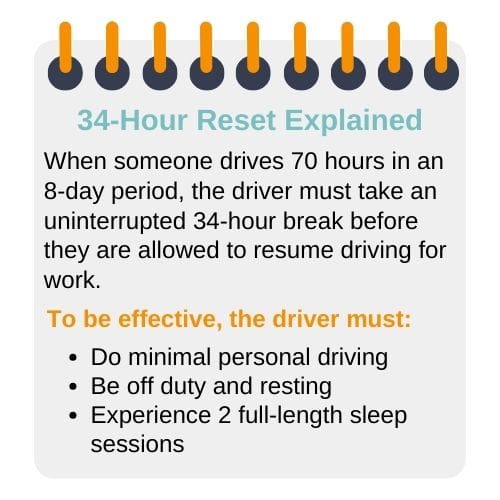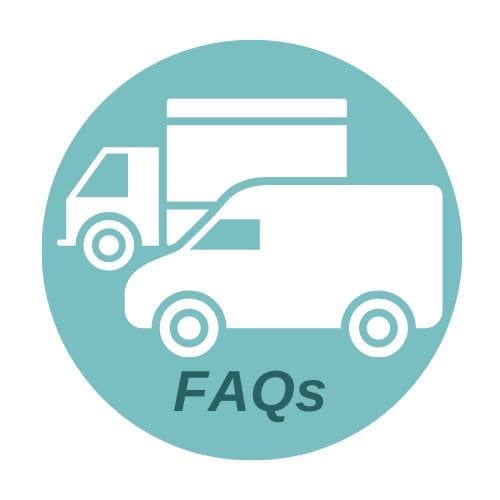
When driving a commercial vehicle, a driver’s alertness and reaction time can be the difference between life and death. Drivers must maintain their mental alertness for every hour they are behind the wheel. However, long and endless hours spent driving can lead to pervasive fatigue, even after a few hours of sleep. This is why the 34-hour reset rule was implemented. The 34-hour reset rule is the counterpoint to the 70-hour rule regarding how long a commercial driver can operate a vehicle, and how long of rest they need after their maximum weekly driving hours.
Because these rules are mandated by federal law, every commercial fleet manager and dispatcher must be aware of the 34-hour reset. You must also implement the time-tracking tools necessary to ensure that every driver is taking the breaks they need to stay mentally sharp behind the wheel. Without the 34-hour reset, drivers would work as many hours as days in the week, collapsing during time off, and never fully recuperating to optimal mental clarity.
This piece will dive into the details of the 34-hour rule, why it works, and best practices for implementation.
Understanding the 34-Hour Reset Rule

The 34-hour rule mandates that commercial truck drivers must rest for 34 consecutive hours after working to their maximum of 69 to 70 hours. Setting the maximum hours of on-duty time to 70 hours a week is known as the 70-hour rule. A driver is not allowed to reset their maximum 70 hours until they have gone through the 34-hour reset.
The duration of 34 hours was determined based on research regarding sleep and mental clarity. It was discovered that one full night of sleep is not enough to recover from the fatigue that results from long driving hours and potentially poor sleep quality over 6-7 days.
In 2013, the federal government passed the 34-hour reset rule as part of the HOS (Hours of Service) regulations. The rule expanded on the pre-determined 70-hour rule, counterbalancing exactly when a commercial driver’s weekly maximum hours were allowed to reset.
It was determined that without this rule, drivers could finish their maximum hours and then immediately reset the clock to start a new week without sufficient rest to achieve continuous road safety. It is not always necessary for drivers to stop for 34 hours between work weeks unless they have reached their maximum driving hours the week before.
Key Components of the 34-Hour Reset
The 34-hour reset must be achieved under specific conditions, both when the reset is required and how it can be completed before drivers can return to duty.
Achieving a Valid Reset Before Returning to Duty
What Counts as a Valid 34-Hour Reset?
- Resets must be spent while the driver is off-duty or resting in their sleeping berth.
- Drivers are permitted to drive a personal vehicle or drive the rig for personal reasons like seeking food and lodgings, but distances must be reasonable and logs must be annotated to clarify HOS compliance.
- The period of 34 hours is intended to include two full-length sleep sessions, however, there is no specific schedule assigned to
Rolling and Fixed Reset Period
For the 34-hour reset requirement to be triggered, a driver must drive more than 70 hours in an 8-day period. However, the law does not specify days of the week. This makes it possible for drivers to maintain a “rolling” rest schedule so that the last 8 days of work do not exceed 70 hours of driving.
A fixed reset, however, assumes that drivers will routinely hit 70 hours within an 8-day period and creates a routine from this premise. In a fixed model, drivers regularly drive for 70 hours and then reset for 34 hours more predictably.
The Top Six Things to Know About the 34-Hour Reset
The 34-hour reset is more nuanced than it appears on the surface. While it appears to be a simple numerical rule, the better you understand the reset, the better you can use it to optimize the performance of your fleet while maintaining regulation compliance. There are six important facts that every logistics and fleet manager should know to plan effective schedules and achieve the purpose of the 34-hour reset.
1. The 34-Hour Reset Must Include Two Full “Nights” Sleep
When the 34-hour reset was first implemented as an HOS regulation in 2013, there was a requirement that it include two spans of 1 am to 5 am. However, this tenet was unpopular among the trucking industry where schedules are far more flexible than most industries. While this structure was removed from the rule in 2015, the intent remains: Drivers should try to get two full night’s sleep with a day of resting in between before returning to work.
2. The Reset is Not Required After Every Weekly Driving Shift
Not every week of commercial driving must be reset using the 34-hour reset. This is where “rolling” rest comes into play. As long as each eight consecutive days do not max out the 70-hour limit, then a 34-hour reset will not be required. If fleet managers or dispatchers want to avoid drivers taking two days off when it is not convenient, they will need to limit daily driving hours to avoid hitting the limit, or supply intermediate days off so that the last 8 days do not reach 70 total hours of driving.
Drivers may also be assigned non-driving tasks to avoid hitting the 70-hour limit while still on the clock. This solution is often preferable for drivers looking to add payable hours to their schedules without mandated off-duty time.
3. It’s a Powerful Tool for Resetting Weekly Driving Limits
The 34-hour limit has two extremely useful purposes. First, it ensures that your drivers are fully refreshed and mentally alert when they return to work. Second, it can allow you to test the weekly driving limit without waiting a full 8 days. Interestingly, you can ask your drivers to take a solid 34 hours to initiate the reset even if 70 hours have not been reached.
For example, your drivers can work their 14-hour limit four days in a row (56 hours), take 34 hours off (1.5 days), and then drive another three 14-hour days (42 hours). This means a total of 98 driving hours in an 8.5-day period rather than the usual limit of 70 hours per 8 rolling days. Using the same math, the rest also allows your drivers to get back on the road faster if their 70 hours were used up too fast
4. The 34 Hours Must Be Continuous and Off-Duty
Unlike other HOS rest mandates, the 34-hour reset must be served continuously and while off-duty. Drivers cannot split their 34 hours into two segments during the week to achieve the reset effect, nor can they work non-driving duties during their reset period.
For drivers who are on a long haul, the reset may include time spent resting in the sleeping berth, and a limited amount of personal driving is permitted as long as the movements are annotated in the log. Drivers may also spend this time in a hotel room, at home, and performing personal tasks. However, it is advised that drivers spend the majority of the 34 hours resting and getting as much sleep as their bodies need.
5. It Doesn’t Affect the 14-Hour Driving Window
While the 34-hour reset is powerful, there is one thing it cannot reset. The 14-hour reset is absolute. No driver can drive more than 14 consecutive hours, followed by 10 hours off-duty. This dictates that in any 24-hour period, only 14 hours can be spent driving and 10 hours must be spent resting. The 34-hour reset can affect the weekly hour limit but not the daily hour limit as set out by the HOS.
6. Flexibility is Key: Choose the Right Time for Your Reset
The best use of the 34-hour reset is when it is most convenient for your drivers to take a 1.5-day break. The reset is mandatory after 70 hours in a consecutive 8-day period, but you can use the reset at any point during the week to help your drivers refresh their energy and their weekly driving limits.
Flexibility can help you build the most efficient schedule, allowing dispatchers to plan for the steadily high demands of the logistics sector while also ensuring that your drivers are well-rested and your operations are HOS-compliant.
Want more industry insights?
Subscribe to our newsletter to receive weekly last mile logistics insights directly to your email inbox each week!
How to Plan for 34-Hour Resets
The best way to make use of the 34-hour reset is to plan ahead. The mandatory reset can throw off a demanding schedule, but planning for the reset can allow drivers and dispatchers to optimize their schedules instead. Dispatchers and drivers can make use of this time to drive more hours in the week and remain fresh without the long-term downsides of an otherwise demanding schedule.
Dispatchers
A clear view of your schedule using a tool like Elite EXTRA is the best way to carefully weave 34-hour resets into each driver’s routine. You can choose to plan “rolling rest” weeks or stagger 34-hour resets to pack more hours into eight consecutive days at a time.
Consider the earlier example, splitting four 14-hour days and three 14-hour days with a 34-hour reset. This achieves more than 90 hours in 8.5 days instead of the usual limit of 70 hours in 8 days per driver. If you truly need to maximize, you can schedule a reset every four 14-hour days (or similar distribution) without ever hitting the 70-hour maximum.
Drivers
Drivers who know that a 34-hour reset is coming can make plans to truly relax. Whether you are on the road or have time to spend at home, a 34-hour reset is an opportunity to take care of personal matters and get some valuable sleep. You can plan quality time with your loved ones, either in person or through digital means. You can take care of shopping, see a doctor for medical concerns, or make sure you have downloaded a marathon of your favorite show to enjoy in your sleeper berth to achieve the full rest period necessary to return from the reset refreshed and ready to drive with clarity.
Benefits of a Well-Executed Rest
There are several benefits to properly implementing the 34-hour reset.
Improved Driver Safety
First, the primary benefit is that your drivers will be refreshed after two full nights of sleep and a day of off-time. After this, alertness, mental clarity, and emotional balance should be restored. This will help drivers to achieve their optimum attention and decision-making for safe driving on the road.
Compliance with HOS Regulations
Dispatchers and fleets that properly implement the 34-hour reset benefit from complete HOS compliance, as well as greater schedule flexibility beyond the rolling rest method of the 70-hour rule.
Increased Operational Safety
Lastly, a team that uses the 34-hour reset has greater overall operational safety. Staggering driver’s reset days ensure that your team remains fresh, reducing the risk of burnout and exhaustion behind the wheel.
FAQs

When is the 34-Hour Reset Required?
Drivers must rest for 34 consecutive hours off-duty after they drive 70 hours within eight consecutive days.
Can the 34-Hour Rest Period Be Split?
No, the reset must be executed with 34 consecutive hours spent resting off-duty.
Can I Reset the Driving Week at Any Time?
Yes. You don’t have to wait until reaching the 70-hour limit, you can reset your 70 hours at any time using the 34-hour reset.
Optimize Your Driver Hours and the 34-Hour Rest Rule.
The 34-hour reset rule is more than just a limitation or a requirement for drivers to rest. It is a tool that can be used to refresh your drivers and reset their 70-hour/8-day limit at any time. With a visual and intuitive logistics scheduling software like Elite EXTRA, you can easily optimize your driver’s schedules and 34-hour resets to achieve the best possible use of driving hours while keeping your drivers mentally clear and fresh when you need their best performance on the road.
Contact Elite EXTRA today to solve your unique logistics challenges.
Sources
https://www.fmcsa.dot.gov/regulations/
https://www.lytx.com/blog/234-hour-reset-for-truck-drivers-how-does-it-work







